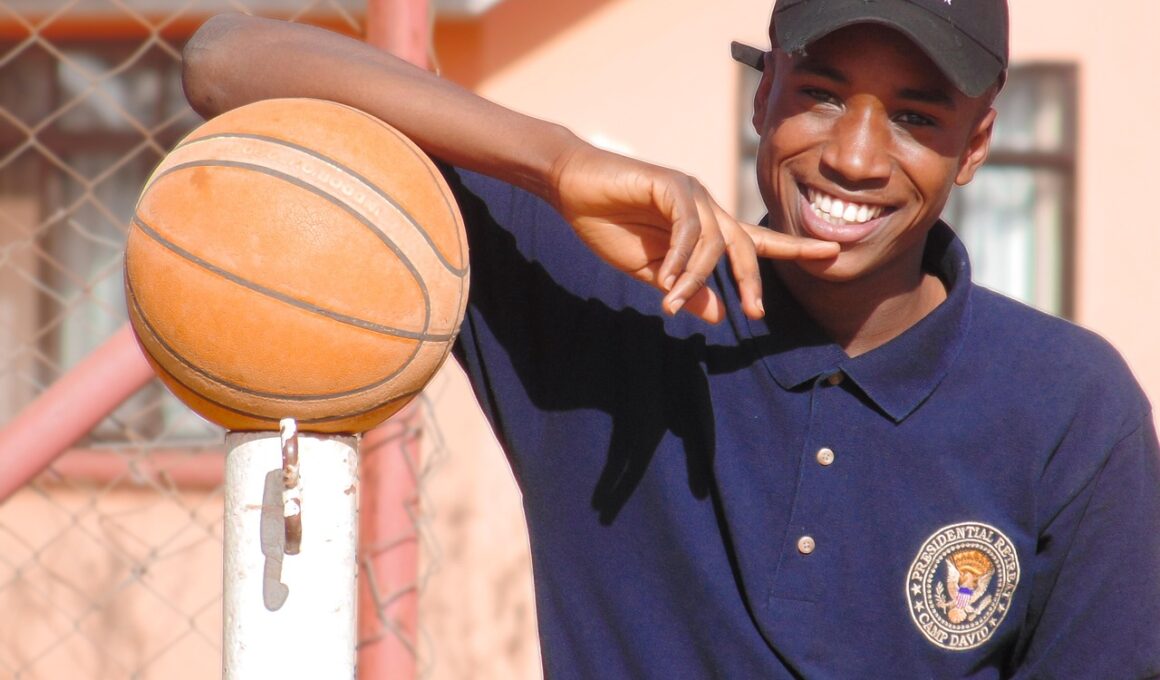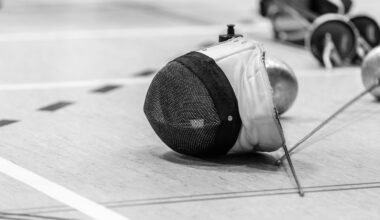The Impact of Footwork on Dribbling Efficiency in Basketball
In basketball, the importance of footwork cannot be overstated, especially concerning dribbling efficiency. Good footwork lays the groundwork for various skills, including ball handling, pivoting, and direction changes. When players maintain a stable and balanced stance, they can utilize dribbling techniques more effectively. This efficiency allows players to maneuver through defenses and create scoring opportunities. Consider the different types of footwork essential for dribbling, such as the jump stop, slide, and crossover movement. Each type serves a unique purpose, enhancing not only dribbling but also overall gameplay. For instance, a jump stop can help players quickly change directions while retaining control of the ball. Similarly, proper sliding techniques allow for better defensive positioning, assisting players in maintaining their dribbling rhythm. The synergy between footwork and dribbling also aids in reducing turnovers, as players with solid footwork can better anticipate teammates’ movements and defenders’ reactions. Consequently, investing time in footwork drills will likely enhance dribbling efficiency and improve game performance overall, leading to better overall outcomes on the court.
To develop solid footwork fundamentals, players can engage in specific drills focusing on agility and coordination. These drills often emphasize lateral movement, forward and backward shifting, and rapid direction changes. For example, practicing cones or ladder drills improves foot speed and precision. Additionally, integrating the use of a basketball during these drills ties the footwork directly to application on the court. Players can practice dribbling while executing footwork techniques, reinforcing the connection between skilled footwork and efficient ball handling. Another effective exercise is shadowing, where players mimic a trainer’s movements. This aids in reinforcing both footwork and dribbling in a dynamic context. Focus on maintaining low centers of gravity while executing these movements to enhance balance. Drills should also incorporate variation in speed and intensity, simulating game scenarios. This helps players become adept at adjusting their footwork based on situational demands. Remember that repetition is vital to mastering these elements. Developing consistency in footwork fundamentals will empower players to enhance their dribbling efficiency, making them formidable on the basketball court during game situations.
Reinforcing Balance through Footwork
Balance is a crucial aspect of effective footwork that significantly impacts dribbling efficiency. Players must develop a keen awareness of their body positioning, as it plays a pivotal role in maintaining equilibrium while dribbling. Training emphasizes the importance of a wide stance and proper distribution of weight among the feet. Players can practice the release of the ball as they approach dribbles, focusing on maintaining balance throughout the process. Furthermore, incorporating balance drills into training, such as single-leg stands or dynamic movements, enhances stability and coordination. By enhancing their balance, players will find it easier to make quick changes in direction while also retaining control of the basketball. This newfound control translates into better dribbling performance by minimizing turnovers and maximizing offensive output. One useful technique is as follows: practice dribbling with the non-dominant hand while performing balance exercises. This enhances coordination and strengthens weaker muscle groups, leading to improved agility. Enhancing balance through footwork not only elevates dribbling efficiency but also prepares players for unexpected situations during games.
The role of footwork in establishing rhythm during dribbling is equally crucial. A consistent rhythm allows players to execute moves more fluidly, directly impacting their ability to score. When players master footwork techniques, they can maintain a smooth dribbling cadence, which keeps defenders guessing and creates opportunities for drives to the basket. An essential element of mastering rhythm is practicing the dribbling timeline: when to accelerate, decelerate, and pivot. By incorporating these dynamics into basic footwork drills, players learn to develop an internal clock. An excellent method to achieve this is using music or a metronome while practicing footwork and dribbling drills. By synchronizing movements to beats, players can cultivate a better sense of timing. Additionally, varying the pace of drills, from slow to fast, helps players adapt their footwork in real-game situations. As players gain confidence in their rhythmic abilities, they become more unpredictable, making them harder to defend against. As a result, refining footwork not only contributes to enhanced dribbling efficiency but also elevates overall basketball skills.
Adapting Footwork for Game Situations
Flexibility in footwork is vital for adapting to changing game situations, especially during high-pressure circumstances. Players must understand how to adjust their foot movements based on the actions of opponents and teammates. Observing opposing defenders can lead to quicker decision-making, allowing players to execute necessary dribbling maneuvers effective counter-moves. Practicing situational drills that mimic gameplay scenarios is beneficial in that regard. Players can perform drills that emphasize quick decision-making under pressure, which helps reinforce their ability to adjust footwork accordingly. One popular drill is the scrimmage variety, where players are divided into teams and compete in small-sided games. This provides an excellent opportunity to practice footwork and dribbling against real-time defenders. Moreover, in-game video analysis can enhance player understanding of footwork execution. Reviewing footage can provide insights into what footwork techniques worked best and which need improvement. This integrative approach fosters a holistic understanding of how footwork impacts gameplay, ultimately allowing players to respond effectively to dynamic situations on the court.
In conclusion, the impact of footwork on dribbling efficiency in basketball is undeniably significant. Players can greatly enhance their ball-handling skills by focusing on foundational footwork techniques. The multifaceted nature of footwork allows for improvements in balance, rhythm, and adaptability during gameplay. Moreover, dedicating time to practice and refine these footwork skills translates directly into better performance on the court. By integrating drills specifically aimed at improving footwork, players can maximize their dribbling efficiency, reducing turnovers, and elevating their scoring potential. It’s essential to emphasize that consistent practice is key. Players should set aside specific times each week to work solely on footwork and its relationship to dribbling. Over time, they will notice the enhancements in their gameplay, leading to greater confidence during competitive matches. Coaches also play a vital role in this process by creating drill regimens that emphasize footwork in conjunction with other basketball skills. Ultimately, embracing a comprehensive approach to footwork and dribbling will lead to significant improvements on the basketball court, transforming players into formidable opponents.
For players aspiring to take their skill set to the next level, understanding the biomechanics of footwork is crucial. Enhancing awareness of how foot movement affects body posture and dribbling performance can be a game-changer. By studying different techniques and their biomechanics, players can become more intentional in their practice sessions. An excellent strategy includes engaging with videos or workshops that dive deep into the science of movement. Many training facilities offer resources that focus on footwork and its mechanics, delivering insights that can accelerate a player’s development. Establishing a consistent training rhythm with check-ins means players are accountable for their progress. Collaboration with coaches or trainers will help identify individual areas for improvement, providing personalized feedback tailored to each player’s needs. This comprehensive approach will ensure that players understand the interplay between footwork and dribbling ability, equipping them with the tools needed for success in competitive environments. With dedication to both footwork and dribbling practice, players will develop not only efficiency but confidence to make game-changing plays.
In Summary, mastering footwork is paramount for maximizing dribbling efficiency in basketball. The intricate relationship between the two forms a solid foundation for skilled gameplay. Players dedicated to refining their footwork can expect to see improved balance and agility, directly influencing their ability on the court. As they master fundamental movements and integrate them into game situations, they will develop the adaptability needed for quick decision-making. Coaches must recognize the significance of footwork and emphasize it within their training programs. By fostering an environment that prioritizes footwork practice, players will notice a marked increase in their overall performance levels. Moreover, as the basketball sport evolves, emphasis on these fundamental skills will enhance individual and team dynamics. Focusing on footwork and dribbling techniques will go a long way in preparing players for higher competition levels. Players committed to their craftsmanship must dedicate time to skill-building, continually assessing their proficiency. Following all these steps will undoubtedly yield successful outcomes on the basketball court, shaping players into proficient athletes capable of meeting the challenges inherent in competitive play.


